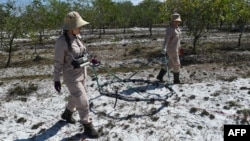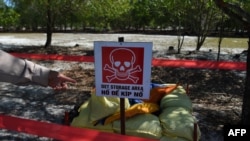The U.S. is committed to removing landmines and other explosive remnants of the war in Vietnam throughout Southeast Asia, according to an annual report released by the State Department.
According to the report, To Walk the Earth in Safety, Vietnam, Laos and Cambodia all face challenges in the safe removal of explosive remnants of war.
Iraq is the largest recipient of the U.S. government's global program, having received more than $675 million since 1993. It is followed in the top five recipients by Afghanistan with nearly $574 million, then Laos with more than $355 million, Vietnam with over $206 million and Cambodia with nearly $192 million.
One of the biggest challenges to the implementation of the conventional weapons destruction (CWD) programs in Vietnam, Laos and Cambodia is the impact of climate change that causes hotter weather, flooding, landslides and droughts, according to the report.
Karen Chandler, deputy assistant secretary of state for the Bureau of Political-Military Affairs at the State Department, told VOA Vietnamese on Tuesday, "There are two effects: One is that unexploded ordnance that previously has been hidden becomes exposed … and suddenly you see all of this new contamination that's been laid bare by these landslides. … Another aspect of it is that it slows down the work and makes it more difficult."
Difficult job, but 'big payoff'
Chandler described the work of removing unexploded ordnance as "a hard job, but one with a big payoff of people's lives and well-being." To leave ordnance behind had "catastrophic consequences for civilians living in proximity to these dangerous depots." Removing the lethal leftovers also boosts food security by making the land safe for cultivation.
The U.S. is the world's single largest financial supporter of CWD programs. Since 1993, the U.S. has spent more than $4.6 billion for the safe clearance of landmines and explosive weapons of war, as well as for securing and safely disposing of excess small arms and light weapons and munitions in more than 120 countries and areas, according to the report.
In fiscal 2022, the U.S. supported conventional weapons destruction in more than 65 countries and areas with more than $376 million.
The U.S. has provided nearly $753 million over the past three decades for conventional weapons destruction in Vietnam, Laos and Cambodia. They receive the largest amounts of U.S. funding for CWD in the East Asia and Pacific region. The three countries received almost $75 million in the past fiscal year. Laos received just over $45 million, Vietnam received more than $20.2 million and Cambodia received the rest, or just over $9.5 million, according to the report.
"Vietnam is one of our longest and strongest programs," Chandler told VOA Vietnamese when referring to the CWD program the U.S. is implementing in more than 120 countries around the world. "Our assistance in the East Asia Pacific region overall spans about $822 million since 1993, and about $168 million of that has been assistance between the United States and the government of Vietnam."
Nguyen Hanh Phuc, deputy director of the Vietnam National Mine Action Center, which partners with the State Department for the CWD programs in Vietnam, told a conference in Hanoi commemorating the International Day for Mine Awareness on April 4 that the unexploded ordnance contaminates 6.1 million hectares. Most of the ordnance is lethal cluster munitions concentrated in the central provinces near the former Demilitarized Zone, according to the report.
Chandler said removal efforts are focused on "addressing the contamination in Quang Binh and Quang Tri provinces. … Those are the central provinces where we see the highest amount of, or the highest density of, legacy contamination from the Vietnam War."
The report said that significant concentrations of unexploded ordnance also remain in parts of southern Vietnam as well as landmine contamination along the country's northern border with China, where the neighboring countries fought in 1979.
40,000 deaths
Vietnamese Prime Minister Pham Minh Chinh said last April that bombs and mines left behind by the U.S. and its allies after the Vietnam War had killed more than 40,000 people and injured 60,000 since 1975.
In Laos, most of the explosive remnants of war are from U.S. aerial bombing campaigns against the communist Pathet Lao conducted during the Vietnam War, according to a 2019 report by the Congressional Research Service, War Legacy Issues in Southeast Asia: Unexploded Ordnance (UXO). Unexploded cluster munitions, referred to locally as “bombies,” remain in most of the country's provinces.
Laos received more than $355 million in 1995 from the U.S. for CWD. During the so-called "shadow war" from 1964 to 1973, the U.S. dropped more than 2 million tons of bombs on Laos, making it, per capita, the most heavily bombed country in history.
In Cambodia, according to the report, in addition to the explosive remnants of war from the Vietnam War, internal conflicts that ended in 1999 also left behind unexploded ordnance. The report said extensive minefields were laid by the Khmer Rouge, Royal Cambodian Armed Forces, and Vietnamese and Thai militaries during fighting and occupations.
"We've provided approximately $191.5 million for clearance operations in Cambodia and about $9 million of that was just this year," said Chandler, adding that the Cambodia Mine Action Center has sent some of its people to train Ukrainian deminers because Cambodians are expert in using a "very specific type of landmine detector that Japan has provided." It is more modern than the aging Russian-built detectors Ukrainians are using as they fight invading Russian forces.
Chandler told VOA Khmer after the briefing that "with the Cambodian government, it's absolutely a priority for us to be able to continue to help Cambodia remove landmines and explosive remnants of war as a way to return lands to Cambodian people and promote economic prosperity and food security."
VOA Khmer's Khemara Pov Sok contributed to this report.








